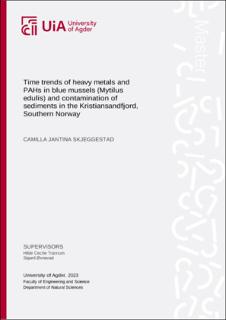| dc.description.abstract | The Kristiansandfjord in Southern Norway has been contaminated for several decades (Green et al., 1985; Berge et al., 2007; Øxnevad et al., 2021). In this study, contaminant concentration data from blue mussel and sediments have been collected, mainly from 2010-2022. The selected contaminants were heavy metals As, Cd, Cr, Cu, Pb, Hg, Ni, as well as PAHs including benzo(a)pyrene. The aims of this study were to describe time trends for concentrations of contaminants in blue mussels and compare contaminant levels at different locations in the fjord. Additional aims were to determine environmental conditions and chemical status of locations in the fjord, and to perform a pollution assessment. The results of this study were discussed considering local industry discharges, as well as other sources of contamination from urban areas. This study found that concentrations of contaminants in blue mussels have with some exceptions remained the same, despite reduced industrial discharges and implemented sediment remediation actions. These measures may however still have contributed to the reduction of contaminant concentrations in the fjord. Contaminant concentrations were the highest at stations near discharge sources in both blue mussel and sediment. All sediment stations had contaminant concentrations leading to «very poor» environmental condition, similarly, all sediment stations had «not good» chemical status and most blue mussel stations had «not good» chemical status. The Kristiansandfjord is polluted with cadmium, copper, mercury, lead, nickel, zinc, and PAHs including benzo(a)pyrene, however, their effects on the ecosystem in the fjord are uncertain yet cause for concern. It may take a substantial amount of time and effort to reduce contaminant concentrations, and further monitoring is necessary. These findings may apply to other fjords and other types of marine ecosystems as well. | |
